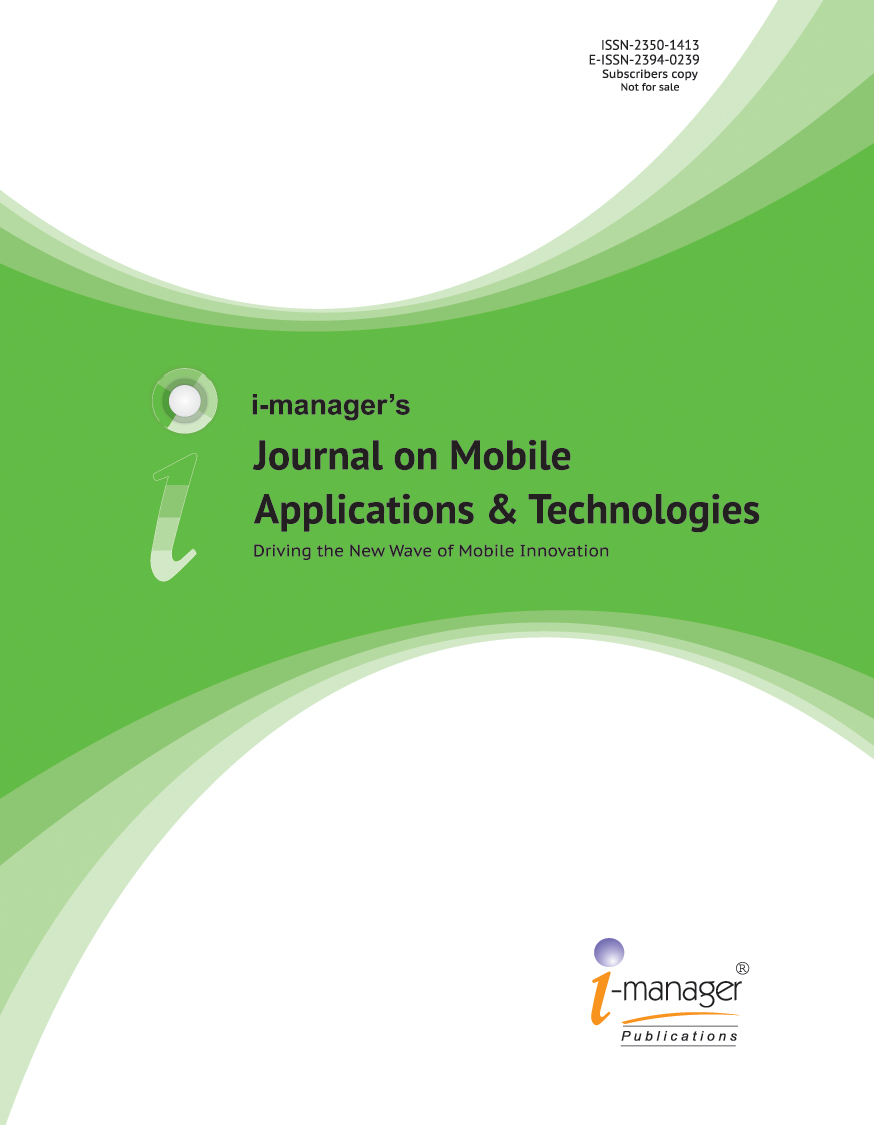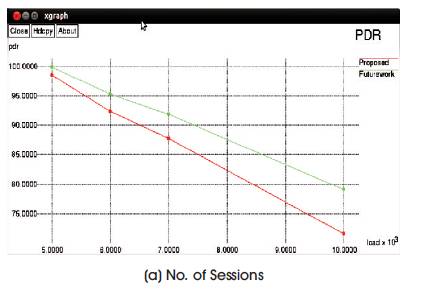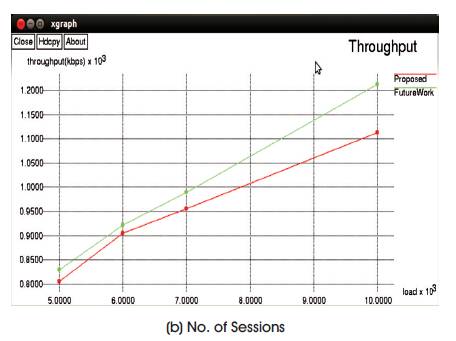 |
i-manager's Journal on Mobile Applications and Technologies |
View PDF |
|||
| Volume :2 | No :4 | Issue :-2016 | Pages :26-32 | ||
Many QoS provisioning solutions were described in the past, but none of them are tested on video traffic and also the effects of mobility and dissimilarity in link quality are not labeled properly. The proposed efficient QoS-Aware Routing Protocol (QARP) that uses Cross-Layer Communication (CLC) and Session Admission Control (SAC) methods to provide QoS is guaranteed in terms of network bandwidth. The QARP performs QoS- aware route discovery by considering the effects of both inter-contention, and intra-contention in the route discovery phase. Only data sessions are considered for which a route with needed bandwidth is found that is admitted into the network by SAC process [14]. The highly varying characteristics of transmitting video data checks the SAC process less reliable due to the unavailability of accurate session bandwidth consumption information. The increase is possibility of wrong admission not only degrades the video quality of admission flows but also affects the quality existing data sessions. In future the service experience of an end user can be used for adoption streaming procedure and presentation assessment of the developing approach in terms of Quality of Experience.
Ad-hoc wireless networks made up of mobile nodes organized by multi hop communication paths. Ad-hoc networks have no permanent network infrastructure. The topology of the network alter dynamically as mobile nodes join or depart the network or radio links between the nodes become unusable. Due to its infrastructure-less, inexpensive and easy-to-deploy nature, the applications of MANETs have developed rapidly. The on-the-fly deployments of MANETs are very useful in disasters like urgent situation and liberate operations performed in flooding, earthquakes and war. For example, in flooded areas, the rescue team can transmit a live video streaming that reflects the exact situation to show the specific impact of disaster to the higher authorities. Based on the expected video feeds, the rescue support teams can take better decisions to manage the present situation in the monitoring areas. In this use case, the lack of information caused by end-to-end delay and quality of the traditional video deeply affects the productivity of orders issued by decision makers [1]. In such scenarios, MANETs are well synchronized, as a result, these kinds of scenarios have no existing infrastructure or the presented setups are no longer useful due to the disaster. Video streaming over the Internet has established well with numerous applications including Huge Definition TV content (HDTV), mobile TV, mobile video chat and surveillance systems. In addition, the amount of multimedia traffic more than wireless networks has increased tremendously due to permanent improvements in transmission technology of wireless networks and physical personality of mobile devices. However, to provide satisfactory Quality-of-Service (QoS) [9] to customer of wireless networks [2], there are many challenges. Among them are some degrees of wireless channel abilities, convention delay and bandwidth bounds of video streaming applications and dealing with dynamic characteristics of wireless atmosphere and multimedia applications data traffic. The multimedia applications have tough requirements in terms of one or more QoS metrics like delay, bandwidth and jitter due to which QoS provisioning is necessary before and during the transmission of data from these functions [2], [3].
Video Transmission in Wireless Internet Studies on video transmission in wireless Internet can be divided into the following classes based on the layered network architecture:
Existing cross-layer video coding and transmission solutions can be divided into the following categories [6]:
1. Network adaptive video coding strategies; typically do not commit joint optimization. This kind of studies adjusts video coding strategies to control streaming rate according to network condition replicated by lower layers (available bandwidth and packet loss rate) [6].
2. Integrated approach, desiring to minimize end-to end video deformation. Optimization generally contains the parameters of several layers, contain application-layer FEC strategy, video packet size, video streaming rate, MAC re-transmission mechanism and modulation and channel selection.
3. Data is transmitted into PHBs (per-Hop behavior) and unequal protection is achieved by different server architectures.
A number of techniques can be employed to eliminate the delay, restore the harm packets, and keep smashed links in mixed networks. All of these mechanisms help to increase the peculiarity of video streaming [7]. Examples of these techniques comprise the Single Description Coding (SDC), Multi Description Coding (MDC), and Layer Description Coding (LDC) techniques.
This technique is interested as the simplest technique used in video communication. It can be implemented by encoding a certain video into one stream. This stream is then classified into a number of encoded frames, which are scattered into multiple paths. The main drawback of this technique is that the streams on one route will depend on the streams on other path. Thus, the received video quality is unsatisfactory [6].
Second type of video transmission technique classify a given stream into many frames. These frames are then opened into a multi-description encoder, which outcomes a number of explanations that have the same acceptation [6]. The decoder then reconstructs the perceived video from any group of perceived confession. The quality of the video is regulated by the number of descriptions that are received accurately. Any explanation can be used to modernize the base video, with the main characteristics of peculiarity, and any recently produced explanation can be used to further increase the video quality [8].
In this category of video transmission technique, each video is split into a number of frames. These frames are divided into BL and EL. These layers are encoded and decoded autonomously of each other. The BL includes the video with the primary characteristics, while the EL is used to increment the quality of the BL. In this technique, using only the EL is ineffective. Thus, the BL is the main part of the LDC technique. Missed packets are re-transmitted using the improvement path, so that this technique decreases the delay [6].
SAC method lies in its reactive nature that has been employed for retrieving the information about the csneighbor's accessible bandwidth while keeping the lowest signaling overhead during bandwidth-aware route discovery process. In addition, the multipath routing protocol which discovers and stores the capacity tested routes suggests to decrease the risk of re-routing in the case of route breaks due to mobility or interference caused by periodic bursty traffic. Furthermore, by considering the throughput and jitter sensitive nature of video traffic, previously they have employed a local route repair model by storing multiple node disjoint routes on the intermediate nodes that can be used for fast rerouting process in the case of link failures. It has been observed from the simulation results that, extremely varied characteristics of transferring video data makes the SAC method less correct because of the inaccessibility of correct session bandwidth overwhelming data. This will increase the prevalence of wrong admissions that does not solely degrade the video quality of admitted flows, however additionally affects the standard of existing data sessions [7].
To perform the main routing functions during route discovery phase, a traditional routing protocol such as Adhoc On-demand Distance Vector (AODV), Optimized Link State Routing (OLSR) or Dynamic Source Routing (DSR) is used. A majority of QoS provisioning results proposed in the past are based on the DSR routing protocol for estimating the available network resources and performing SAC. QoS-aware routing, SAC process should admit only those sessions for which a route is available in this way that not only the nodes on the route have the sufficient resources to support the flow but their csneighbors also have the adequate resources to support the flow without affecting any already admitted flow. To ensure that the cs-neighbors of an elected flow have sufficient residual capacity, many solutions that use active and passive approaches to collect the required data from their cs-neighbors are proposed in the literature. To discover a bandwidth-aware route between a specific source-destination pair, each node in the network should know their current locally available bandwidth at any time during the simulation. The most correct way given in the literature to calculate the local available capacity of a node is by taking the ratio of its unproductive time to its busy time over a fraction of time. Any change in the available bandwidth of each node will disturb the other nodes lying within its two hop radius [7].
Adaptive streaming makes changes at the server and the client to increase the overall quality of experience of the end-user (viewer). These modifications also directly impact the network characteristics of adaptive streaming. Finally, these modifications bricks the way for extensions to enable the delivery of live streams.
To guide adaptive streaming, the content must first be encoded at multiple bit-rates which must be pre-defined by the operator to offer an adequate tradeoff between quality and bit-rate. In order to diminish the bit rate, the content can be encoded at minor resolution and/or lower frame rates than the source.
The adaptive part of adaptive streaming is promoted at the client rather than the server. The client frequently monitors the accessible bandwidth and the media being passed, and will dynamically switch to a higher or lower bit-rate session in order to keep the accept buffer within set limits. Seamless adaptive streaming means that the user sees no visible disruption in this process, because segments are aligned to closed GOP boundaries.
Adaptive streaming is a process that alters the quality of a video delivered to a web page based on modifying network conditions to ensure the best probable viewer experience. Adaptive streaming simplifies content formation and management, making streaming video easy to deploy, and does not desire any coding [13] .
When originally released, Adobe's Dynamic Streaming completely uses the Real Time Messaging Protocol (RTMP) to disburse video to viewers, which has multiple drawbacks as compared to technologies that use the most general Hypertext Transfer Protocol (HTTP), which include HLS and continues Streaming. Initially, as a server based technology, the initial implementation of Dynamic Streaming desired a persistent connection between server and player, which probably can increase implementation cost and limit deployment adaptability. Second, RTMP packets may have complication getting through certain firewalls, though the Flash Media Server has work arounds if these troubles are experienced. Third, video packets passed via HTTP can more easily leverage standard HTTP caching accessible within the networks of ISPs, corporations, and other organizations, which can improve distribution efficiency and quality of service [10]. Finally, there's a general attention among technical cognoscenti that stream switching works more practically using the chunk-based delivery used by HTTP-based adaptive streaming technologies [11].
The proposed algorithm performs the following steps:
Step 1: Initiate Client Request by connecting to the Server with information about multiple connection links.
Step 2: Server Receives Request and identifies the occurrences of two links.
Step 3: Server response with stream prepared message and start sending video packets.
Step 4: After making connection, the data is send over the direct connection defined protocol and after that it makes data transmission through other connection.
Step 5: Multiple connections processed by one another agent works as a forward node.
Step 6: Client Initiates the two separate network data path.
Step 7: Server initiates bandwidth measurement for each link.
Step 8: Based on the bandwidth server, split the video content into separate stream and end through both link.
Step 9: Client receives the data coming through two links to a unique buffer.
Step 10: Stop.
Calculate bandwidth parameters,
PLR = Total no. of packets transmitted/ Total no. of packets received (N-R)/N
= (100-80)/100=1/5=0.2
Local available bandwidth,
γ.BWavg loc (n) + (1-γ) (Tidle /0.25).BW net total(n)
= 1.50 + (1-1) (Tidle /0.25).BWnet total t(n)
= 50
Total amount of bandwidth (BWtotal )
N (BWtotal ) = N (BWreq ).N (Ccount) +BW extra,
= 1040*21+BWextra
=1040*21+20
=21860
Before sending a video file, it is encoded using a given bit rate. High bit rate means lesser the compression ratio of video hence higher its quality. All the simulation results offered in this paper are generated by taking the average of ten random simulation that runs on each situation. The values of the simulation parameters used for scenario creation are shown in Table1.

Table 1. Simulation Parameters
Figures 1 and 2 show the source node transmitting data 2000 to the node via 2 1 34. The source node is 2 and the destination node is 34. The node 2 transmitts the data 2000 to the node 1 at time 1.5 sec.

Figure 1. Selection of Shortest Path from Source to Destination

Figure 2. Transmission of Packets
Figure 3 shows the packet delivery ratio which is the ratio between the number of packets transmitted to the total number of packets received. Figure 4 shows the Packet Delivery ratio verses Number of Sessions and Number of Packets Received at Destination.

Figure 3. Packet Delivery Ratio


Figure 4 (a) Packet Delivery ratio verses Number of Sessions (b) Number of Packets Received at Destination
The comparision between bandwidth aware routing protocol and adaptive video streaming technique for different parameters are shown in Table 2.

Table 2. Comparison Table
Routing overhead for all the comparing protocols is larger in mobile network as co-ordinated to the static networks, because mobility increments the route break which cause frequent rerouting (Figure 5). In addition to this, in the mobile networks, the BAND-MR has even lesser routing overhead messages as matched to BAPBR and BA-CSR due to the higher probability that it gets an opportunity to use the secondary route whenever the primary route at source or transitional nodes is broken. By using adaptive video streaming algorithms, increment the packet delivery ratio and throughput. When compare to BANDMR algorithm adaptive video streaming techniques is increment the quality of experience.

Figure 5. Comparison between Adaptive Streaming Algorithm and Adaptive Video Streaming Technique
The proposed adaptive streaming method provides an excellent quality of experience for video deliverance over the general network. It uses hypertext transfer protocol for security companionable. Adaptive streaming is also the only major capability for delivering the right quality of service to a various range of addressees. As usual, on the other hand, not all technologies are created equal and there's no one-size-fits-all resolution. In future by exploitation, the advanced adaptive techniques will improve the PSNR, PDR, etc.